Directions ACT: A Comprehensive Report on AOD Services in Canberra
VerifiedAdded on 2023/06/14
|9
|2068
|173
Report
AI Summary
This report provides an analysis of Directions ACT, an AOD organization in Canberra, detailing its services and programs aimed at minimizing the harms of alcohol and drug addiction. It covers various aspects including counseling, sterile injecting equipment, referral, support, detoxification, and rehabilitation services. The report examines different models of addiction such as moral, disease, psycho-dynamic, social learning, social-cultural, public health, and stages of change models, and their application within the organization. It also explores how political, social, and environmental contexts affect the organization's services, emphasizing client rights and safety, relevant legislation, and the values and philosophies of the AOD sector. Furthermore, the report outlines a current AOD policy framework and its impact on AOD work practice.
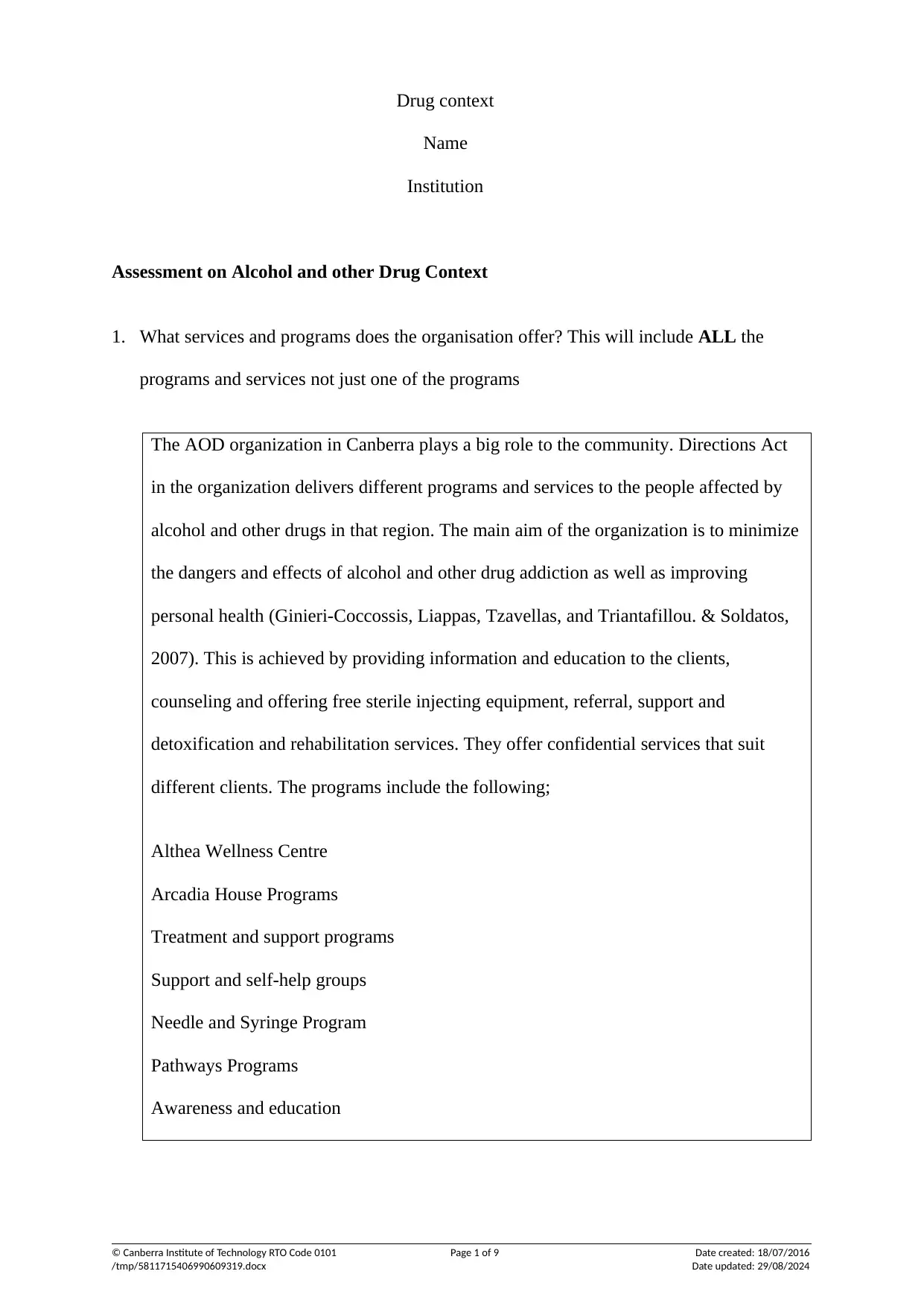
Drug context
Name
Institution
Assessment on Alcohol and other Drug Context
1. What services and programs does the organisation offer? This will include ALL the
programs and services not just one of the programs
The AOD organization in Canberra plays a big role to the community. Directions Act
in the organization delivers different programs and services to the people affected by
alcohol and other drugs in that region. The main aim of the organization is to minimize
the dangers and effects of alcohol and other drug addiction as well as improving
personal health (Ginieri-Coccossis, Liappas, Tzavellas, and Triantafillou. & Soldatos,
2007). This is achieved by providing information and education to the clients,
counseling and offering free sterile injecting equipment, referral, support and
detoxification and rehabilitation services. They offer confidential services that suit
different clients. The programs include the following;
Althea Wellness Centre
Arcadia House Programs
Treatment and support programs
Support and self-help groups
Needle and Syringe Program
Pathways Programs
Awareness and education
© Canberra Institute of Technology RTO Code 0101 Page 1 of 9 Date created: 18/07/2016
/tmp/5811715406990609319.docx Date updated: 29/08/2024
Name
Institution
Assessment on Alcohol and other Drug Context
1. What services and programs does the organisation offer? This will include ALL the
programs and services not just one of the programs
The AOD organization in Canberra plays a big role to the community. Directions Act
in the organization delivers different programs and services to the people affected by
alcohol and other drugs in that region. The main aim of the organization is to minimize
the dangers and effects of alcohol and other drug addiction as well as improving
personal health (Ginieri-Coccossis, Liappas, Tzavellas, and Triantafillou. & Soldatos,
2007). This is achieved by providing information and education to the clients,
counseling and offering free sterile injecting equipment, referral, support and
detoxification and rehabilitation services. They offer confidential services that suit
different clients. The programs include the following;
Althea Wellness Centre
Arcadia House Programs
Treatment and support programs
Support and self-help groups
Needle and Syringe Program
Pathways Programs
Awareness and education
© Canberra Institute of Technology RTO Code 0101 Page 1 of 9 Date created: 18/07/2016
/tmp/5811715406990609319.docx Date updated: 29/08/2024
Paraphrase This Document
Need a fresh take? Get an instant paraphrase of this document with our AI Paraphraser
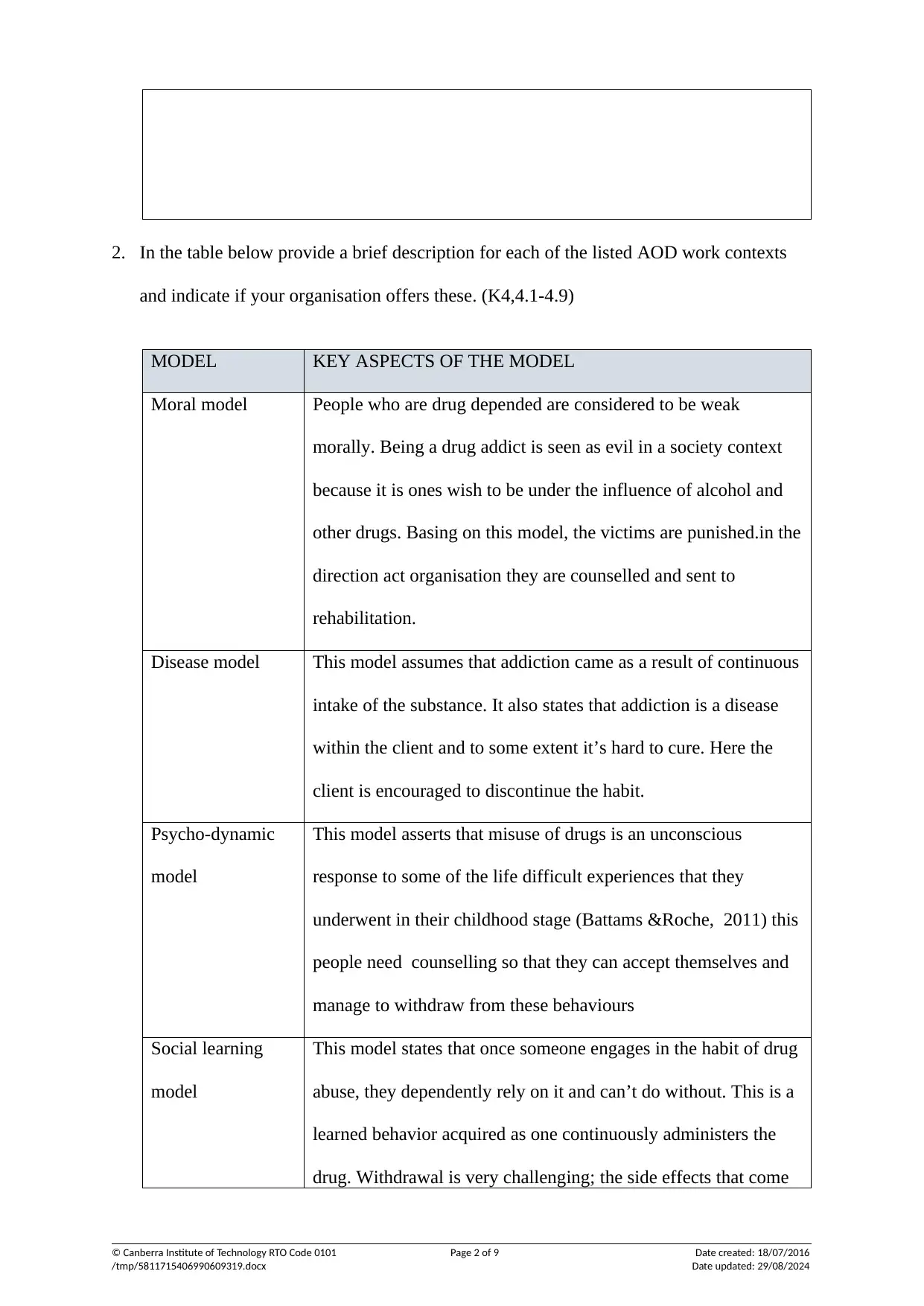
2. In the table below provide a brief description for each of the listed AOD work contexts
and indicate if your organisation offers these. (K4,4.1-4.9)
MODEL KEY ASPECTS OF THE MODEL
Moral model People who are drug depended are considered to be weak
morally. Being a drug addict is seen as evil in a society context
because it is ones wish to be under the influence of alcohol and
other drugs. Basing on this model, the victims are punished.in the
direction act organisation they are counselled and sent to
rehabilitation.
Disease model This model assumes that addiction came as a result of continuous
intake of the substance. It also states that addiction is a disease
within the client and to some extent it’s hard to cure. Here the
client is encouraged to discontinue the habit.
Psycho-dynamic
model
This model asserts that misuse of drugs is an unconscious
response to some of the life difficult experiences that they
underwent in their childhood stage (Battams &Roche, 2011) this
people need counselling so that they can accept themselves and
manage to withdraw from these behaviours
Social learning
model
This model states that once someone engages in the habit of drug
abuse, they dependently rely on it and can’t do without. This is a
learned behavior acquired as one continuously administers the
drug. Withdrawal is very challenging; the side effects that come
© Canberra Institute of Technology RTO Code 0101 Page 2 of 9 Date created: 18/07/2016
/tmp/5811715406990609319.docx Date updated: 29/08/2024
and indicate if your organisation offers these. (K4,4.1-4.9)
MODEL KEY ASPECTS OF THE MODEL
Moral model People who are drug depended are considered to be weak
morally. Being a drug addict is seen as evil in a society context
because it is ones wish to be under the influence of alcohol and
other drugs. Basing on this model, the victims are punished.in the
direction act organisation they are counselled and sent to
rehabilitation.
Disease model This model assumes that addiction came as a result of continuous
intake of the substance. It also states that addiction is a disease
within the client and to some extent it’s hard to cure. Here the
client is encouraged to discontinue the habit.
Psycho-dynamic
model
This model asserts that misuse of drugs is an unconscious
response to some of the life difficult experiences that they
underwent in their childhood stage (Battams &Roche, 2011) this
people need counselling so that they can accept themselves and
manage to withdraw from these behaviours
Social learning
model
This model states that once someone engages in the habit of drug
abuse, they dependently rely on it and can’t do without. This is a
learned behavior acquired as one continuously administers the
drug. Withdrawal is very challenging; the side effects that come
© Canberra Institute of Technology RTO Code 0101 Page 2 of 9 Date created: 18/07/2016
/tmp/5811715406990609319.docx Date updated: 29/08/2024
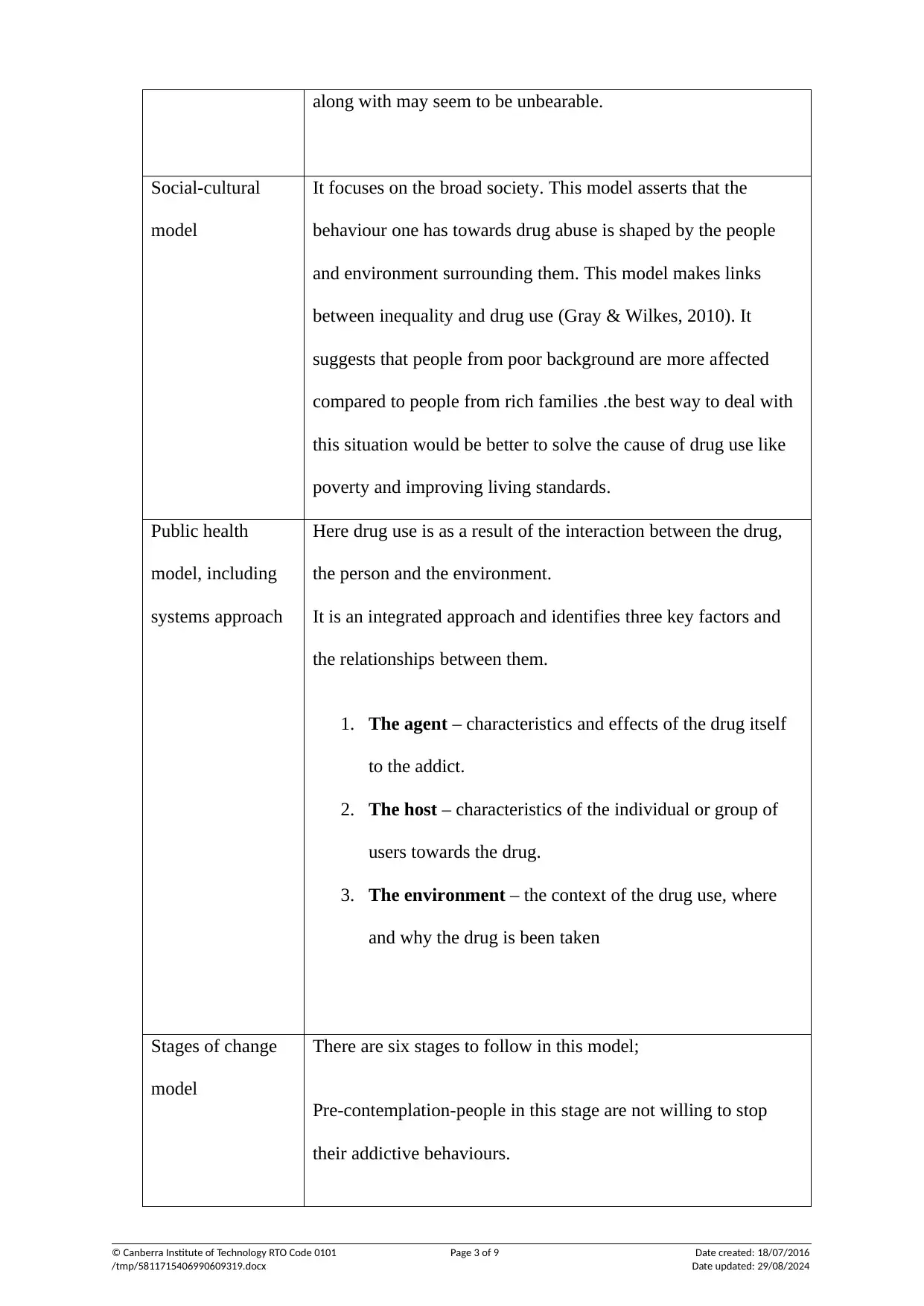
along with may seem to be unbearable.
Social-cultural
model
It focuses on the broad society. This model asserts that the
behaviour one has towards drug abuse is shaped by the people
and environment surrounding them. This model makes links
between inequality and drug use (Gray & Wilkes, 2010). It
suggests that people from poor background are more affected
compared to people from rich families .the best way to deal with
this situation would be better to solve the cause of drug use like
poverty and improving living standards.
Public health
model, including
systems approach
Here drug use is as a result of the interaction between the drug,
the person and the environment.
It is an integrated approach and identifies three key factors and
the relationships between them.
1. The agent – characteristics and effects of the drug itself
to the addict.
2. The host – characteristics of the individual or group of
users towards the drug.
3. The environment – the context of the drug use, where
and why the drug is been taken
Stages of change
model
There are six stages to follow in this model;
Pre-contemplation-people in this stage are not willing to stop
their addictive behaviours.
© Canberra Institute of Technology RTO Code 0101 Page 3 of 9 Date created: 18/07/2016
/tmp/5811715406990609319.docx Date updated: 29/08/2024
Social-cultural
model
It focuses on the broad society. This model asserts that the
behaviour one has towards drug abuse is shaped by the people
and environment surrounding them. This model makes links
between inequality and drug use (Gray & Wilkes, 2010). It
suggests that people from poor background are more affected
compared to people from rich families .the best way to deal with
this situation would be better to solve the cause of drug use like
poverty and improving living standards.
Public health
model, including
systems approach
Here drug use is as a result of the interaction between the drug,
the person and the environment.
It is an integrated approach and identifies three key factors and
the relationships between them.
1. The agent – characteristics and effects of the drug itself
to the addict.
2. The host – characteristics of the individual or group of
users towards the drug.
3. The environment – the context of the drug use, where
and why the drug is been taken
Stages of change
model
There are six stages to follow in this model;
Pre-contemplation-people in this stage are not willing to stop
their addictive behaviours.
© Canberra Institute of Technology RTO Code 0101 Page 3 of 9 Date created: 18/07/2016
/tmp/5811715406990609319.docx Date updated: 29/08/2024
⊘ This is a preview!⊘
Do you want full access?
Subscribe today to unlock all pages.

Trusted by 1+ million students worldwide
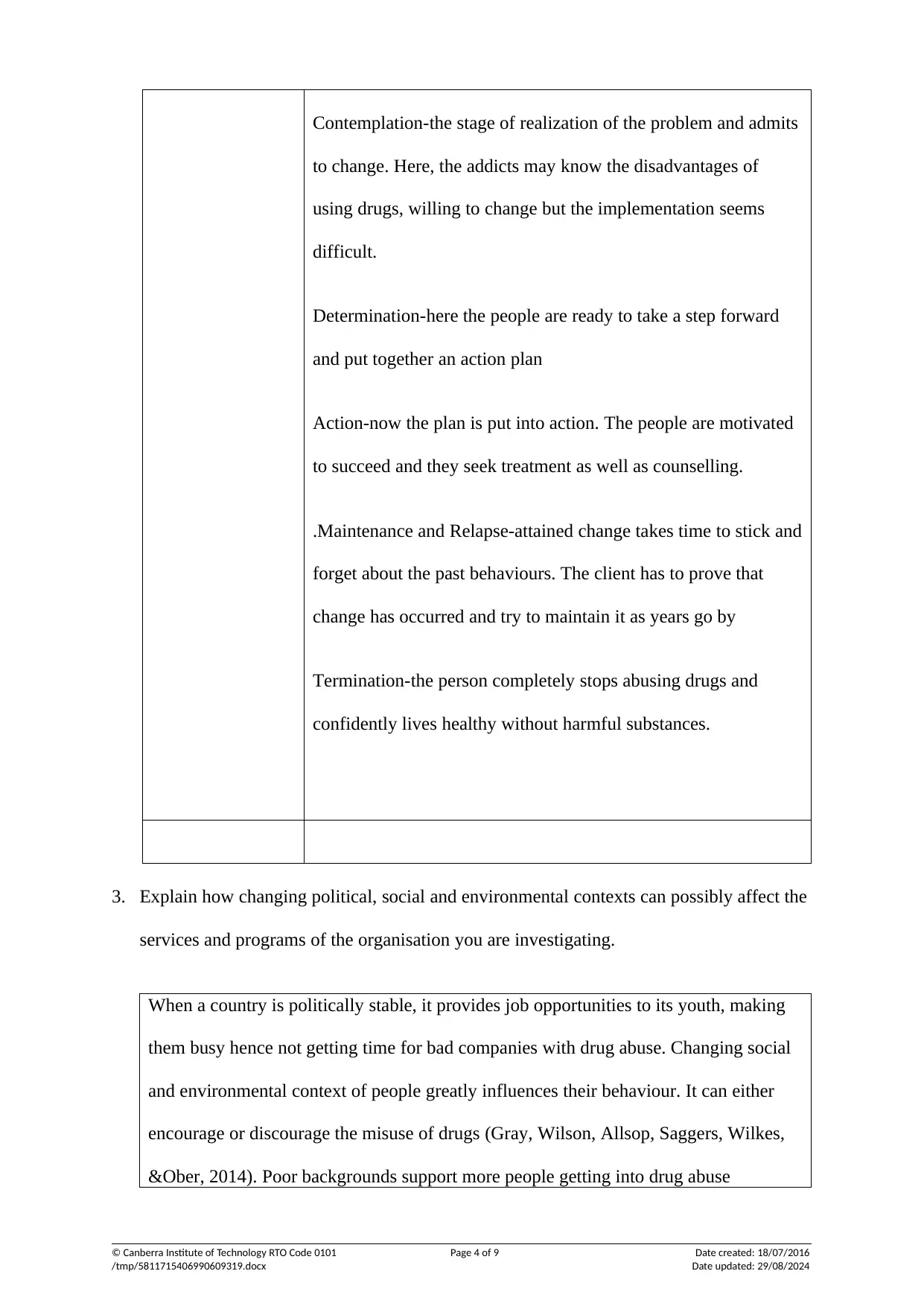
Contemplation-the stage of realization of the problem and admits
to change. Here, the addicts may know the disadvantages of
using drugs, willing to change but the implementation seems
difficult.
Determination-here the people are ready to take a step forward
and put together an action plan
Action-now the plan is put into action. The people are motivated
to succeed and they seek treatment as well as counselling.
.Maintenance and Relapse-attained change takes time to stick and
forget about the past behaviours. The client has to prove that
change has occurred and try to maintain it as years go by
Termination-the person completely stops abusing drugs and
confidently lives healthy without harmful substances.
3. Explain how changing political, social and environmental contexts can possibly affect the
services and programs of the organisation you are investigating.
When a country is politically stable, it provides job opportunities to its youth, making
them busy hence not getting time for bad companies with drug abuse. Changing social
and environmental context of people greatly influences their behaviour. It can either
encourage or discourage the misuse of drugs (Gray, Wilson, Allsop, Saggers, Wilkes,
&Ober, 2014). Poor backgrounds support more people getting into drug abuse
© Canberra Institute of Technology RTO Code 0101 Page 4 of 9 Date created: 18/07/2016
/tmp/5811715406990609319.docx Date updated: 29/08/2024
to change. Here, the addicts may know the disadvantages of
using drugs, willing to change but the implementation seems
difficult.
Determination-here the people are ready to take a step forward
and put together an action plan
Action-now the plan is put into action. The people are motivated
to succeed and they seek treatment as well as counselling.
.Maintenance and Relapse-attained change takes time to stick and
forget about the past behaviours. The client has to prove that
change has occurred and try to maintain it as years go by
Termination-the person completely stops abusing drugs and
confidently lives healthy without harmful substances.
3. Explain how changing political, social and environmental contexts can possibly affect the
services and programs of the organisation you are investigating.
When a country is politically stable, it provides job opportunities to its youth, making
them busy hence not getting time for bad companies with drug abuse. Changing social
and environmental context of people greatly influences their behaviour. It can either
encourage or discourage the misuse of drugs (Gray, Wilson, Allsop, Saggers, Wilkes,
&Ober, 2014). Poor backgrounds support more people getting into drug abuse
© Canberra Institute of Technology RTO Code 0101 Page 4 of 9 Date created: 18/07/2016
/tmp/5811715406990609319.docx Date updated: 29/08/2024
Paraphrase This Document
Need a fresh take? Get an instant paraphrase of this document with our AI Paraphraser
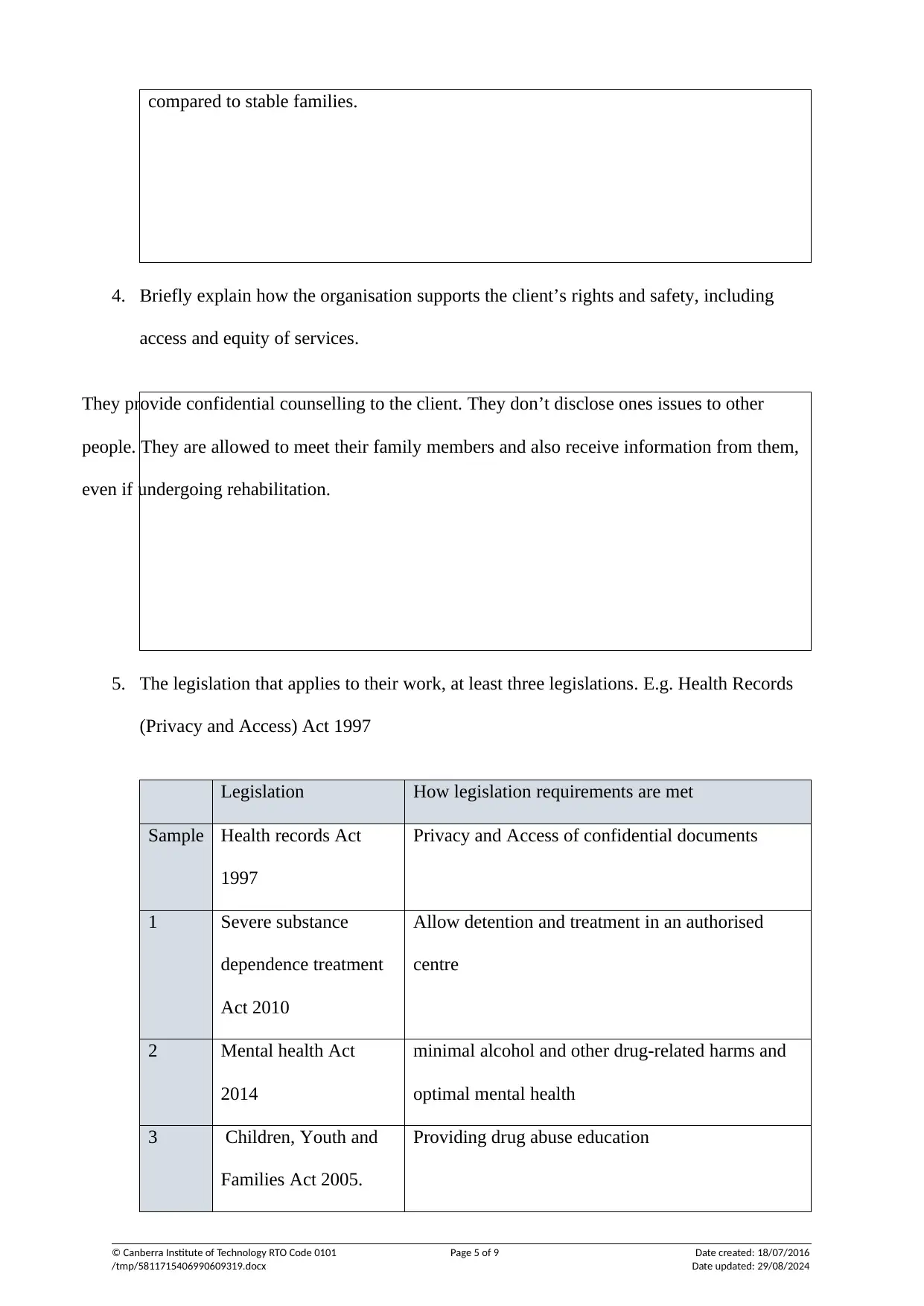
compared to stable families.
4. Briefly explain how the organisation supports the client’s rights and safety, including
access and equity of services.
They provide confidential counselling to the client. They don’t disclose ones issues to other
people. They are allowed to meet their family members and also receive information from them,
even if undergoing rehabilitation.
5. The legislation that applies to their work, at least three legislations. E.g. Health Records
(Privacy and Access) Act 1997
Legislation How legislation requirements are met
Sample Health records Act
1997
Privacy and Access of confidential documents
1 Severe substance
dependence treatment
Act 2010
Allow detention and treatment in an authorised
centre
2 Mental health Act
2014
minimal alcohol and other drug-related harms and
optimal mental health
3 Children, Youth and
Families Act 2005.
Providing drug abuse education
© Canberra Institute of Technology RTO Code 0101 Page 5 of 9 Date created: 18/07/2016
/tmp/5811715406990609319.docx Date updated: 29/08/2024
4. Briefly explain how the organisation supports the client’s rights and safety, including
access and equity of services.
They provide confidential counselling to the client. They don’t disclose ones issues to other
people. They are allowed to meet their family members and also receive information from them,
even if undergoing rehabilitation.
5. The legislation that applies to their work, at least three legislations. E.g. Health Records
(Privacy and Access) Act 1997
Legislation How legislation requirements are met
Sample Health records Act
1997
Privacy and Access of confidential documents
1 Severe substance
dependence treatment
Act 2010
Allow detention and treatment in an authorised
centre
2 Mental health Act
2014
minimal alcohol and other drug-related harms and
optimal mental health
3 Children, Youth and
Families Act 2005.
Providing drug abuse education
© Canberra Institute of Technology RTO Code 0101 Page 5 of 9 Date created: 18/07/2016
/tmp/5811715406990609319.docx Date updated: 29/08/2024
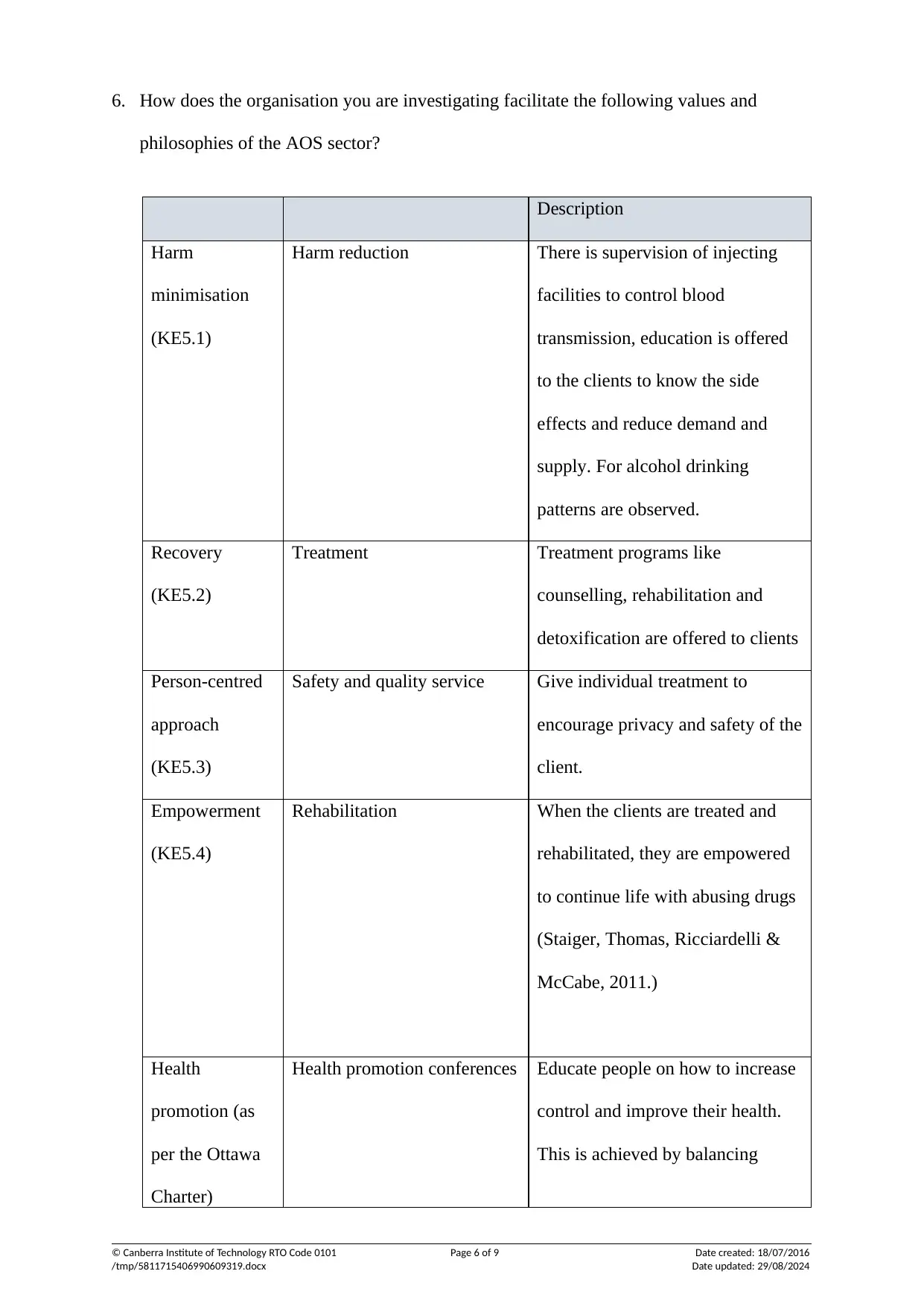
6. How does the organisation you are investigating facilitate the following values and
philosophies of the AOS sector?
Description
Harm
minimisation
(KE5.1)
Harm reduction There is supervision of injecting
facilities to control blood
transmission, education is offered
to the clients to know the side
effects and reduce demand and
supply. For alcohol drinking
patterns are observed.
Recovery
(KE5.2)
Treatment Treatment programs like
counselling, rehabilitation and
detoxification are offered to clients
Person-centred
approach
(KE5.3)
Safety and quality service Give individual treatment to
encourage privacy and safety of the
client.
Empowerment
(KE5.4)
Rehabilitation When the clients are treated and
rehabilitated, they are empowered
to continue life with abusing drugs
(Staiger, Thomas, Ricciardelli &
McCabe, 2011.)
Health
promotion (as
per the Ottawa
Charter)
Health promotion conferences Educate people on how to increase
control and improve their health.
This is achieved by balancing
© Canberra Institute of Technology RTO Code 0101 Page 6 of 9 Date created: 18/07/2016
/tmp/5811715406990609319.docx Date updated: 29/08/2024
philosophies of the AOS sector?
Description
Harm
minimisation
(KE5.1)
Harm reduction There is supervision of injecting
facilities to control blood
transmission, education is offered
to the clients to know the side
effects and reduce demand and
supply. For alcohol drinking
patterns are observed.
Recovery
(KE5.2)
Treatment Treatment programs like
counselling, rehabilitation and
detoxification are offered to clients
Person-centred
approach
(KE5.3)
Safety and quality service Give individual treatment to
encourage privacy and safety of the
client.
Empowerment
(KE5.4)
Rehabilitation When the clients are treated and
rehabilitated, they are empowered
to continue life with abusing drugs
(Staiger, Thomas, Ricciardelli &
McCabe, 2011.)
Health
promotion (as
per the Ottawa
Charter)
Health promotion conferences Educate people on how to increase
control and improve their health.
This is achieved by balancing
© Canberra Institute of Technology RTO Code 0101 Page 6 of 9 Date created: 18/07/2016
/tmp/5811715406990609319.docx Date updated: 29/08/2024
⊘ This is a preview!⊘
Do you want full access?
Subscribe today to unlock all pages.

Trusted by 1+ million students worldwide
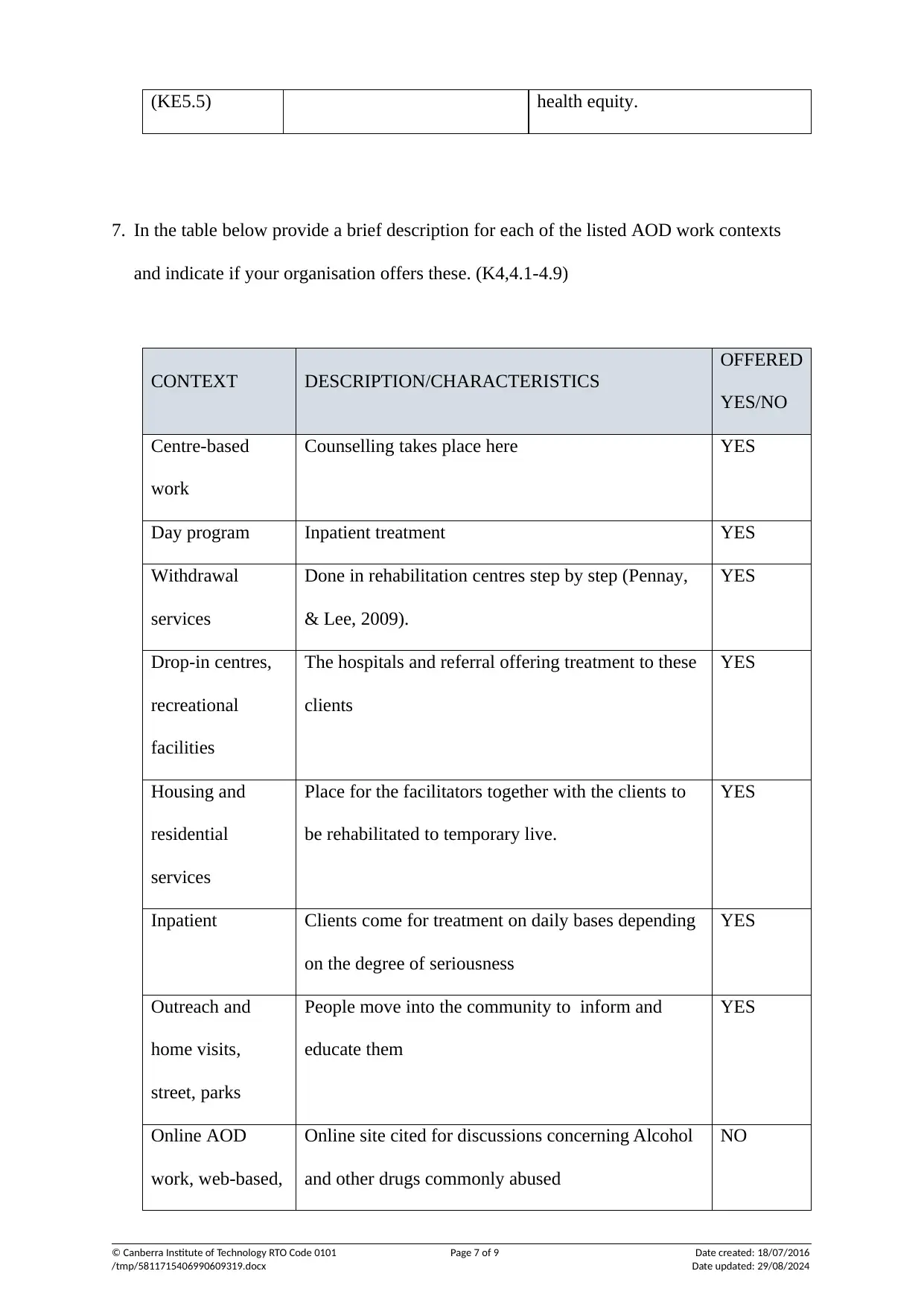
(KE5.5) health equity.
7. In the table below provide a brief description for each of the listed AOD work contexts
and indicate if your organisation offers these. (K4,4.1-4.9)
CONTEXT DESCRIPTION/CHARACTERISTICS
OFFERED
YES/NO
Centre-based
work
Counselling takes place here YES
Day program Inpatient treatment YES
Withdrawal
services
Done in rehabilitation centres step by step (Pennay,
& Lee, 2009).
YES
Drop-in centres,
recreational
facilities
The hospitals and referral offering treatment to these
clients
YES
Housing and
residential
services
Place for the facilitators together with the clients to
be rehabilitated to temporary live.
YES
Inpatient Clients come for treatment on daily bases depending
on the degree of seriousness
YES
Outreach and
home visits,
street, parks
People move into the community to inform and
educate them
YES
Online AOD
work, web-based,
Online site cited for discussions concerning Alcohol
and other drugs commonly abused
NO
© Canberra Institute of Technology RTO Code 0101 Page 7 of 9 Date created: 18/07/2016
/tmp/5811715406990609319.docx Date updated: 29/08/2024
7. In the table below provide a brief description for each of the listed AOD work contexts
and indicate if your organisation offers these. (K4,4.1-4.9)
CONTEXT DESCRIPTION/CHARACTERISTICS
OFFERED
YES/NO
Centre-based
work
Counselling takes place here YES
Day program Inpatient treatment YES
Withdrawal
services
Done in rehabilitation centres step by step (Pennay,
& Lee, 2009).
YES
Drop-in centres,
recreational
facilities
The hospitals and referral offering treatment to these
clients
YES
Housing and
residential
services
Place for the facilitators together with the clients to
be rehabilitated to temporary live.
YES
Inpatient Clients come for treatment on daily bases depending
on the degree of seriousness
YES
Outreach and
home visits,
street, parks
People move into the community to inform and
educate them
YES
Online AOD
work, web-based,
Online site cited for discussions concerning Alcohol
and other drugs commonly abused
NO
© Canberra Institute of Technology RTO Code 0101 Page 7 of 9 Date created: 18/07/2016
/tmp/5811715406990609319.docx Date updated: 29/08/2024
Paraphrase This Document
Need a fresh take? Get an instant paraphrase of this document with our AI Paraphraser
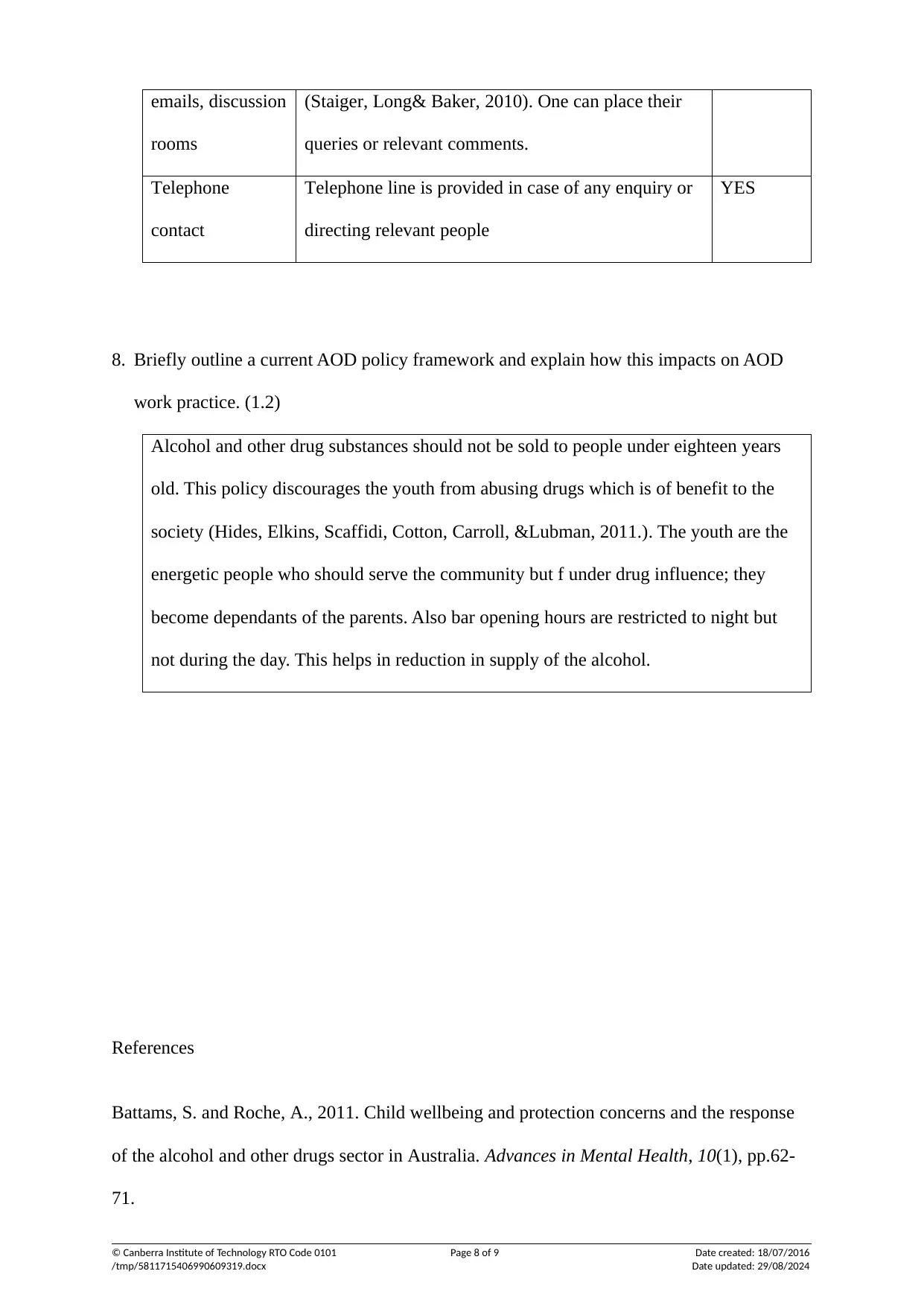
emails, discussion
rooms
(Staiger, Long& Baker, 2010). One can place their
queries or relevant comments.
Telephone
contact
Telephone line is provided in case of any enquiry or
directing relevant people
YES
8. Briefly outline a current AOD policy framework and explain how this impacts on AOD
work practice. (1.2)
Alcohol and other drug substances should not be sold to people under eighteen years
old. This policy discourages the youth from abusing drugs which is of benefit to the
society (Hides, Elkins, Scaffidi, Cotton, Carroll, &Lubman, 2011.). The youth are the
energetic people who should serve the community but f under drug influence; they
become dependants of the parents. Also bar opening hours are restricted to night but
not during the day. This helps in reduction in supply of the alcohol.
References
Battams, S. and Roche, A., 2011. Child wellbeing and protection concerns and the response
of the alcohol and other drugs sector in Australia. Advances in Mental Health, 10(1), pp.62-
71.
© Canberra Institute of Technology RTO Code 0101 Page 8 of 9 Date created: 18/07/2016
/tmp/5811715406990609319.docx Date updated: 29/08/2024
rooms
(Staiger, Long& Baker, 2010). One can place their
queries or relevant comments.
Telephone
contact
Telephone line is provided in case of any enquiry or
directing relevant people
YES
8. Briefly outline a current AOD policy framework and explain how this impacts on AOD
work practice. (1.2)
Alcohol and other drug substances should not be sold to people under eighteen years
old. This policy discourages the youth from abusing drugs which is of benefit to the
society (Hides, Elkins, Scaffidi, Cotton, Carroll, &Lubman, 2011.). The youth are the
energetic people who should serve the community but f under drug influence; they
become dependants of the parents. Also bar opening hours are restricted to night but
not during the day. This helps in reduction in supply of the alcohol.
References
Battams, S. and Roche, A., 2011. Child wellbeing and protection concerns and the response
of the alcohol and other drugs sector in Australia. Advances in Mental Health, 10(1), pp.62-
71.
© Canberra Institute of Technology RTO Code 0101 Page 8 of 9 Date created: 18/07/2016
/tmp/5811715406990609319.docx Date updated: 29/08/2024
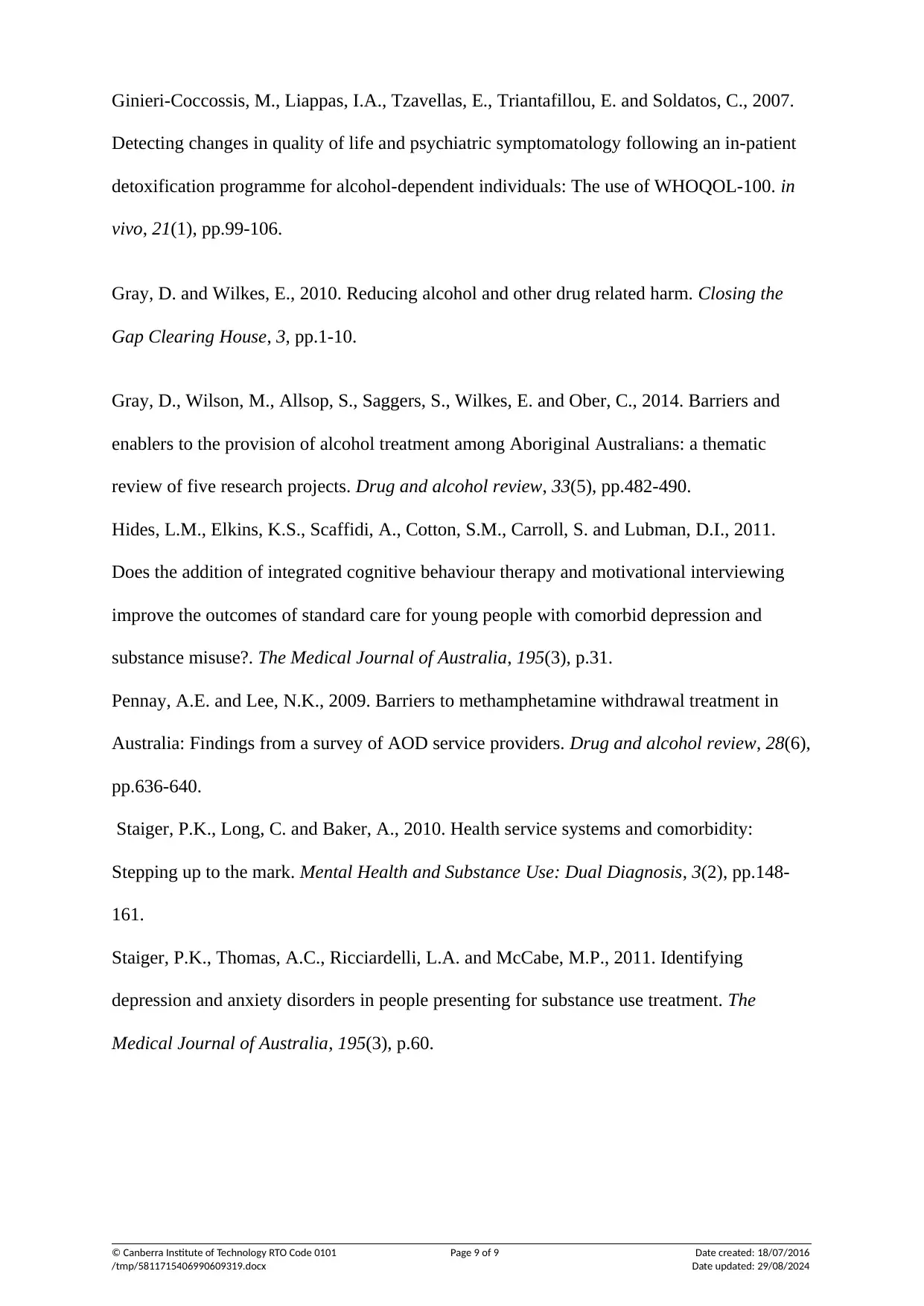
Ginieri-Coccossis, M., Liappas, I.A., Tzavellas, E., Triantafillou, E. and Soldatos, C., 2007.
Detecting changes in quality of life and psychiatric symptomatology following an in-patient
detoxification programme for alcohol-dependent individuals: The use of WHOQOL-100. in
vivo, 21(1), pp.99-106.
Gray, D. and Wilkes, E., 2010. Reducing alcohol and other drug related harm. Closing the
Gap Clearing House, 3, pp.1-10.
Gray, D., Wilson, M., Allsop, S., Saggers, S., Wilkes, E. and Ober, C., 2014. Barriers and
enablers to the provision of alcohol treatment among Aboriginal Australians: a thematic
review of five research projects. Drug and alcohol review, 33(5), pp.482-490.
Hides, L.M., Elkins, K.S., Scaffidi, A., Cotton, S.M., Carroll, S. and Lubman, D.I., 2011.
Does the addition of integrated cognitive behaviour therapy and motivational interviewing
improve the outcomes of standard care for young people with comorbid depression and
substance misuse?. The Medical Journal of Australia, 195(3), p.31.
Pennay, A.E. and Lee, N.K., 2009. Barriers to methamphetamine withdrawal treatment in
Australia: Findings from a survey of AOD service providers. Drug and alcohol review, 28(6),
pp.636-640.
Staiger, P.K., Long, C. and Baker, A., 2010. Health service systems and comorbidity:
Stepping up to the mark. Mental Health and Substance Use: Dual Diagnosis, 3(2), pp.148-
161.
Staiger, P.K., Thomas, A.C., Ricciardelli, L.A. and McCabe, M.P., 2011. Identifying
depression and anxiety disorders in people presenting for substance use treatment. The
Medical Journal of Australia, 195(3), p.60.
© Canberra Institute of Technology RTO Code 0101 Page 9 of 9 Date created: 18/07/2016
/tmp/5811715406990609319.docx Date updated: 29/08/2024
Detecting changes in quality of life and psychiatric symptomatology following an in-patient
detoxification programme for alcohol-dependent individuals: The use of WHOQOL-100. in
vivo, 21(1), pp.99-106.
Gray, D. and Wilkes, E., 2010. Reducing alcohol and other drug related harm. Closing the
Gap Clearing House, 3, pp.1-10.
Gray, D., Wilson, M., Allsop, S., Saggers, S., Wilkes, E. and Ober, C., 2014. Barriers and
enablers to the provision of alcohol treatment among Aboriginal Australians: a thematic
review of five research projects. Drug and alcohol review, 33(5), pp.482-490.
Hides, L.M., Elkins, K.S., Scaffidi, A., Cotton, S.M., Carroll, S. and Lubman, D.I., 2011.
Does the addition of integrated cognitive behaviour therapy and motivational interviewing
improve the outcomes of standard care for young people with comorbid depression and
substance misuse?. The Medical Journal of Australia, 195(3), p.31.
Pennay, A.E. and Lee, N.K., 2009. Barriers to methamphetamine withdrawal treatment in
Australia: Findings from a survey of AOD service providers. Drug and alcohol review, 28(6),
pp.636-640.
Staiger, P.K., Long, C. and Baker, A., 2010. Health service systems and comorbidity:
Stepping up to the mark. Mental Health and Substance Use: Dual Diagnosis, 3(2), pp.148-
161.
Staiger, P.K., Thomas, A.C., Ricciardelli, L.A. and McCabe, M.P., 2011. Identifying
depression and anxiety disorders in people presenting for substance use treatment. The
Medical Journal of Australia, 195(3), p.60.
© Canberra Institute of Technology RTO Code 0101 Page 9 of 9 Date created: 18/07/2016
/tmp/5811715406990609319.docx Date updated: 29/08/2024
⊘ This is a preview!⊘
Do you want full access?
Subscribe today to unlock all pages.

Trusted by 1+ million students worldwide
1 out of 9
Your All-in-One AI-Powered Toolkit for Academic Success.
+13062052269
info@desklib.com
Available 24*7 on WhatsApp / Email
![[object Object]](/_next/static/media/star-bottom.7253800d.svg)
Unlock your academic potential
Copyright © 2020–2025 A2Z Services. All Rights Reserved. Developed and managed by ZUCOL.

